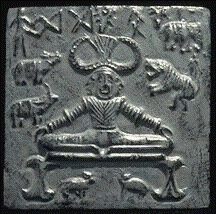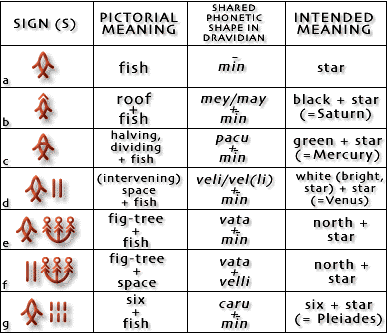Namaste, Readers!
What I would like to achieve in this post is to identify and explore the gods of the Indus Civilization, as it is of the world's oldest major civilizations. I also am asking about this because the Indus valley writing has not been deciphered, and so we can't easily read their tablets to see exactly what they thought about this issue.
Let me begin by saying a bit about this society. The Indus Civilization, also known as the Harappan Civilization, began about 3500 BC and lasted to about 1500 BC. The others comparable to it in the years 3500-2400 BC are Egypt and Sumer. The Minoan, Chinese, and Peruvian societies up to 2400 BC were small or less developed. For example, the first Chinese dynasty didn't start until 2100 BC, and findings of writing by Chinese are very rare until the Shang dynasty of 1700 BC.
One of the uncertainties or still-disputed points in archaeology is whether the Indus civilization had a major Indo-European component at its start, or whether they arrived after the climax of this major civilization. It's an interesting question, which I think only DNA tests on many remains will answer fully. As for its language, even today, about 63% of Pakistanis are non-Indo-European, lacking R1A DNA, and there are Dravidian-speaking tribes in Pakistan. So the most common educated guess by scholars is that the Harappan culture usually spoke Dravidian. Many consider it to be a mixed pictographic-phonetic language like some major Mesopotamian languages were in that era. In those languages, a picture could mean either a sound or a whole word.
(REFERENCE: Y-DNA haplogroups in South Asian populations, Wikipedia, https://en.wikipedia.org/wiki/Y-DNA_haplogroups_in_South_Asian_populations)
Regardless, scholars see overlap between Hinduism and the Indus Valley religion, although they might not be exactly the same - the Indus religion could be an earlier stage of Hinduism, with some differences. Consider that one of the most commonly found figures is a figure seated in the lotus position that reminds some scholars of Shiva Pashupati (Shiva as lord of animals). They notice that he is shown with horns, unlike later Hindu depictions of Shiva, which at most show him with a moon sign on his head.
(IMAGE SOURCE: http://www.geocities.ws/indianpagani...ti_lotus_1.gif)
Considering these facts, what can we show basically from archaeology, but with possible secondary help from Hinduism, about the Indus Valley Civilization's gods?
Asko Parpolo, a Finnish researcher whose work is featured on the Harappa.com website, proposed that the fish sign in Indus writing meant fish, star or god(deity) in his essay "Deciphering the Indus script". (https://www.harappa.com/script/parpola0.html). One of his reasons was that in Dravidian, fish and star are both "meena" and also that the star sign was used in Sumerian to refer to "deity". He gave other reasons that I find persuasive, like finding the fish sign used together with pictures depicting deities, proper names, or religion. Next he made a claim that is more doubtful to me - he claimed that the seated figure was a water god or had a major association with water. He noted that the god's picture was shown with fish signs. But this seems doubtful evidence to me, because he had just claimed that the fish sign was used linguistically to mean a deity. By extension then, it doesn't necessarily follow that the deity is a water god, although some other researchers have also proposed a connection of this figure with water, and he gives a few more reasons.
In a chapter called Saturn and the Tortoise, he proposes that this fish sign meaning "star" was sometimes written with a "roof" on top to give it an added meaning. He proposes that the roof sign can also mean "black", because roof and black have shared Dravidian phonetics - "vey" or "mey", with the latter meaning black.
He gives this tablet:
REFERENCE: https://www.harappa.com/script/parpola9.html
He writes:
REFERENCE: https://www.harappa.com/script/parpola9.htmlAmong the diacritical marks added to the basic 'fish' sign is one that has been placed over the 'fish' sign and looks like a 'roof' (Fig. 13, b ). The most wide- spread root from which words denoting 'roof' are derived in the various Dravidian languages is *vay- : *vey- : *mey- 'to cover a house with a thatched roof', in which etymon the alternations *v- / *m- and *-ay- / *-ey- can be reconstructed for Proto-Dravidian 3. Thus in Proto-Dravidian the root *vey- / *mey- 'to roof' was partially homophonous with the root *may- 'black'. The sequence of the pictograms for 'roof' and 'fish' in the Indus script can be read in Proto-Dravidian as *mey-meen in the sense of *may-meen 'black star'. What makes this reading really significant is that the last-mentioned compound is factually attested as the name of the planet Saturn in the oldest available Dravidian texts, the poems of the Sangam literature written in Old Tamil in the early centuries of our era (Purananuru 117). Such a name is natural for Saturn, which is a dim planet, the root *may- (Tamil mai- ) meaning not only 'to be or become black' but also 'to be dim'.
So far, what he is saying is reasonable - Old Tamil writings call Saturn "black star", Saturn is in fact a dim planet, and the planets were commonly called stars by ancient societies. Next he explains his theory that this was part of Indus Valley worship:
REFERENCE: https://www.harappa.com/script/parpola9.htmlThe oldest Sanskrit texts dealing with the worship of the planets also associate Saturn with the colour black. They further mention Yama, the Hindu god of death, as the deity presiding over this dark planet. Yama is associated with the colour black in the Brahmana texts of the Veda (cf. e.g. Maitrayane Samhita 3,14,11 yamaya krsna). In classical Hinduism, Yama's colour is black and his vehicle usually the dark water buffalo. The planet Saturn, too, is said to ride the water buffalo in some texts.
So here he makes a connection to Hindu worship of planets, its consideration of Saturn and the death god Yama as black. He also implies a connection between them since the black Saturn and black Yama are both riding a water buffalo. And by mentioning the water buffalo, he implies a close connection to the seated horned Shiva-like figure of the tablet. Maybe he is implying that the tablet's seated Shiva figure was associated with Saturn, but he doesn't say it directly.
Next he makes a connection between Saturn's "slowness" in Hindu thought and the Tortoise, which he imagines is depicted as a fish with a roof:
REFERENCE: https://www.harappa.com/script/parpola9.htmlSaturn is not only a dark but also a slow planet; in fact, for this reason it is usually called sani or sanaiscara 'slowly-going' in Sanskrit. In the iconography of the Buddhists and the Jains, the planet Saturn rides the tortoise, whose slowness is proverbial. It seems quite likely to me that this association of the planet Saturn with the tortoise may go back to the Harappan times: the compounded Indus sign depicting a fish with a roof over it could, then, symbolize the deified planet Saturn even pictorially through his vehicle, for the tortoise is an aquatic animal (i.e. a kind of 'fish') covered with a shell (i.e. a kind of roof)!
By talking about the Buddhists and Jains as seeing Saturn riding the tortoise he is able to use Dharmic thought and Indian traditions as an added justification. All the connections he makes seem reasonable and educated, but still to me they do not seem fully certain unfortunately.
Another god many scholars consider to have been part of Indus religion is Krishna. But in his next chapter "Other planets: examples of cross-checked readings" Parpola's reasoning seems weaker in connecting them to Krishna:
REFERENCE: https://www.harappa.com/script/parpola10.htmlAnother diacritic sign is drawn either directly or obliquely across the body of the 'fish' pictogram (Fig. 14, 13c). It could denote 'halving' or 'dividing into two parts': the corresponding Proto-Dravidian root, *pacu , is homophonous with Proto-Dravidian *pacu 'green'. The resulting compound, * pacu-meen 'halved fish' & 'green star', is not known as such from Dravidian languages, but in Old Tamil the word paccai literally meaning 'greenness' is attested as the name of the planet Mercury, and simultaneously as the name of the green-hued pastoral god Krsna.
I understand that the fish symbol is divided and that the Dravidian "half" means green too (as a cognate), thus associating it with Mercury. But is Krishna really "green"?
https://s-media-cache-ak0.pinimg.com...f45be354fa.jpg
SEE ALSO THIS IMAGE:
http://www.dgreetings.com/janmashtam...-Teachings.jpg
I thought Krishna is commonly considered light blue, although I found those images of Krishna wearing green.
Next, he proposes "that many of the stable combinations of Indus pictograms ending in the 'fish' sign denote Dravidian planetary names of the type 'COLOUR' + ('fish' =) 'star' ".
So one of the examples he gives is:
REFERENCE; https://www.harappa.com/script/parpola10.htmlThe word for 'white' that has the widest distribution among in the Dravidian languages is vel. The compound vel + meen (assimilated into vel-meen ) 'white (or bright) star' is known from Old Tamil as the name of the planet Venus, that brightest star of the morning and evening sky; and the noun vell-i , derived from the root vel , denotes 'planet Venus' in a number of Dravidian languages. The meaning of its homophone veli 'enclosed or intervening space, open space' could hardly be expressed better pictorially by any other symbol than 'two long vertical strokes'.
In Tamil, at least, the word velli is used not only in the meaning of 'planet Venus' but in the general meaning of 'star' as well.
This is his conclusion about the sign in row D in the chart I showed above, with the fish next to "two long vertical strokes".









 Reply With Quote
Reply With Quote

Bookmarks